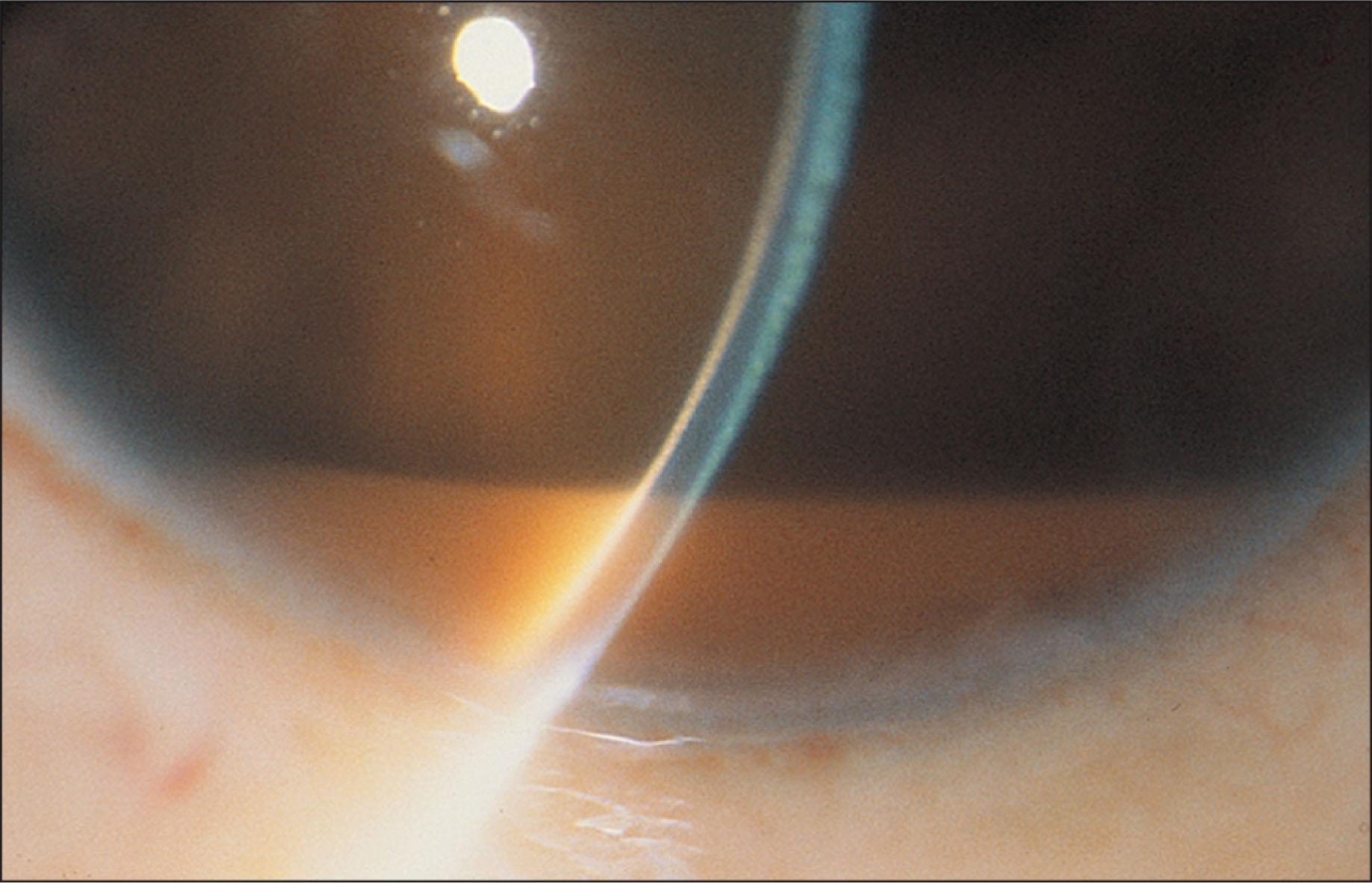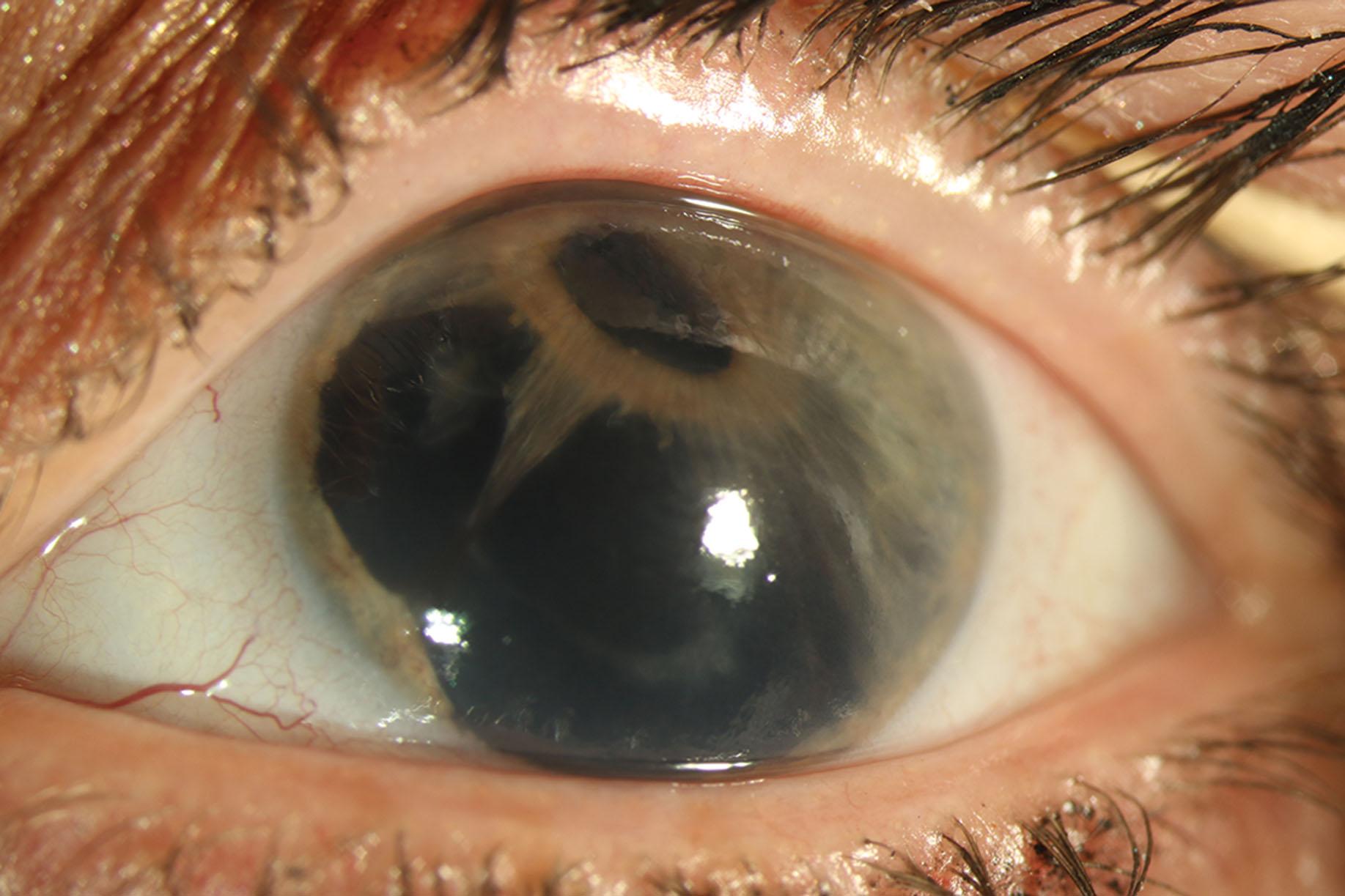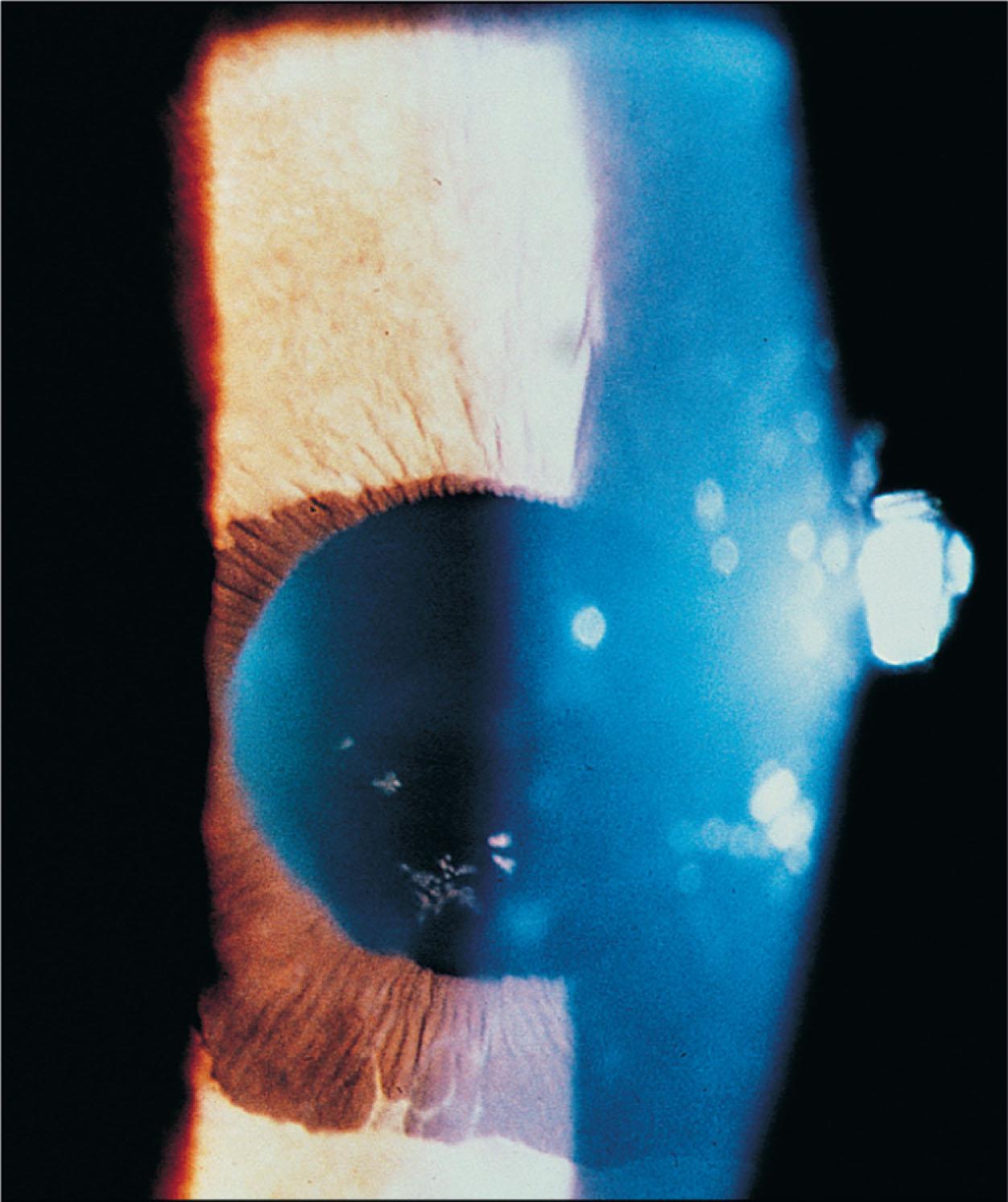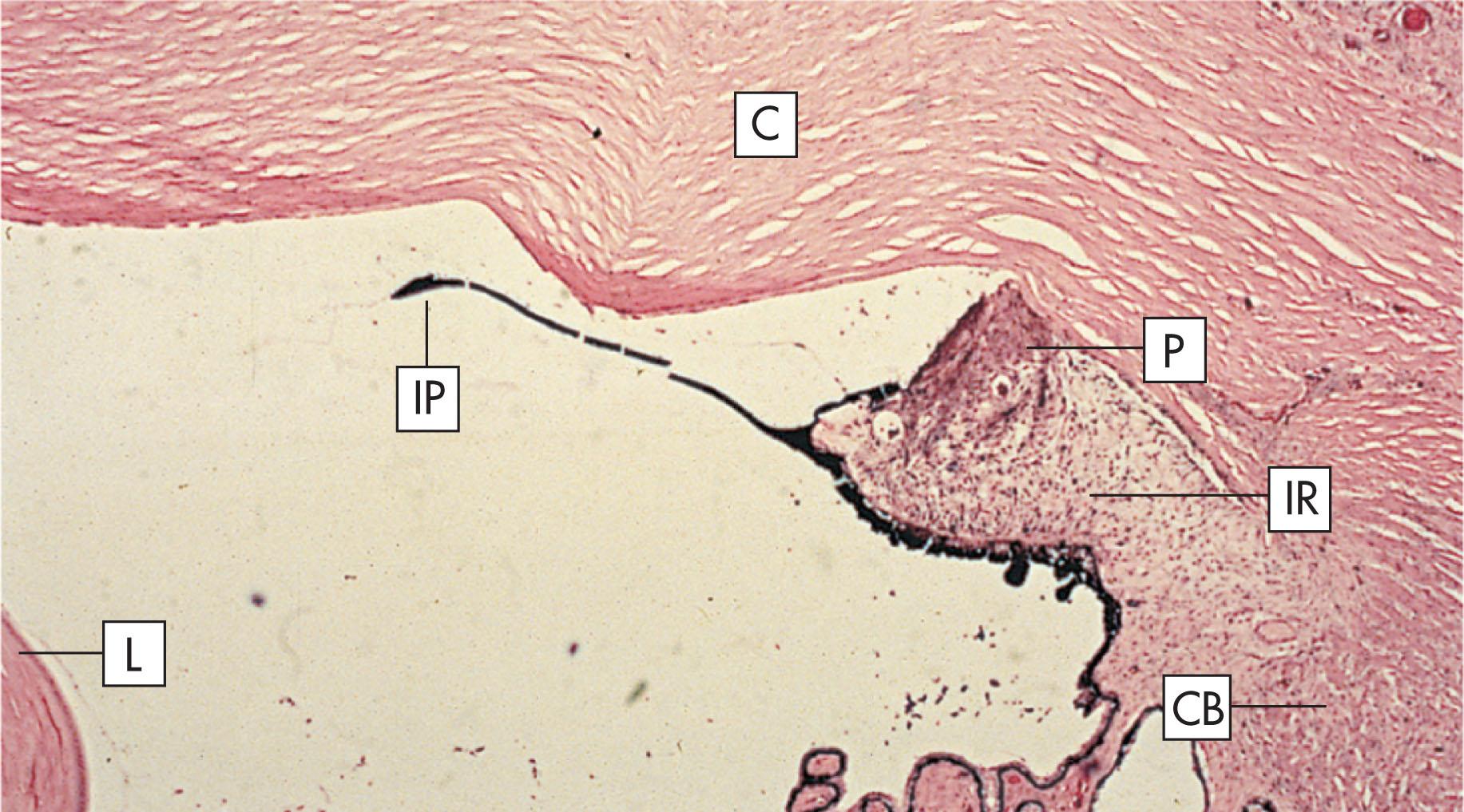Physical Address
304 North Cardinal St.
Dorchester Center, MA 02124
A diverse group of secondary glaucomas, either open or closed angle, caused by specific abnormalities of the anterior and/or posterior segment. The open-angle varieties include ghost cell hemolytic glaucoma and Schwartz’s syndrome. The closed-angle glaucomas include the iridocorneal endothelial syndromes, Axenfeld–Rieger syndrome, epithelial downgrowth and fibrous ingrowth (proliferation), aniridia, and intraocular tumors. Other conditions feature either mixed or nonspecific mechanisms of elevated intraocular pressure, such as the postcorneal transplant and postalkali injury glaucomas.
Iris abnormalities.
Previous intraocular surgery.
Rhegmatogenous retinal detachment.
Elevated intraocular pressure.
Ocular tumors.
Lysed red blood cells (RBCs) from vitreous hemorrhage can accumulate in the eye if not properly cleared. Remnants of these partially degraded cells contain very little hemoglobin and are referred to as ghost cells, which can cause blockage of the trabecular meshwork. These denatured erythrocytes develop within 2–4 weeks of a vitreous hemorrhage. Any traumatic event that leads to hemorrhage in the vitreous cavity or, rarely, in the anterior chamber may result in the formation of ghost cell glaucoma.
The membrane remnants (ghost cells) have lost their intracellular hemoglobin and appear as khaki-colored cells that are less flexible than normal RBCs. This loss of pliability results in obstruction of the normal trabecular meshwork pathways and subsequent development of secondary glaucoma. For the remnant RBCs to gain access to the anterior chamber, the hyaloid face or posterior lens capsule must be disrupted (which may occur after surgery).
The usual history is a chronic vitreous hemorrhage resulting in a sudden onset of elevated intraocular pressure (IOP). The IOP level may be sufficient to cause corneal edema. The anterior chamber is filled with circulating, small, tan-colored cells that layer in the inferior anterior chamber angle ( Fig. 10.19.1 ). The cellular reaction appears out of proportion to the aqueous flare, and the conjunctiva tends not to be inflamed unless the IOP is markedly elevated. On gonioscopy the angle appears normal except for the presence of ghost cells layered over the inferior trabecular meshwork.

Ghost cells lose their hemoglobin through permeable cell membranes. The cells are nonpliable, having lost their natural biconcavity, and are unable to exit through the trabecular meshwork efficiently. Heinz bodies (denatured hemoglobin) can be found in the cytoplasm.
The initial treatment is antiglaucoma medical therapy, followed by intraocular surgery in eyes that are nonresponsive to medical treatment. Irrigation of the anterior chamber and pars plana vitrectomy are the initial surgeries of choice to eliminate the source of degenerative RBCs. If this proves unsuccessful, glaucoma filtration surgery may be required.
The first description of chronic open-angle glaucoma secondary to rhegmatogenous retinal detachment was presented in 1973 by Schwartz. These patients presented with retinal detachments and increased IOP. The elevated IOP resolved after repair of the retinal detachment. All patients had an apparent anterior chamber inflammatory response. Retinal detachments are covered in detail in Chapter 6 , Section 7.
In 1977, Phelps and Burton surveyed 817 patients who underwent retinal detachment repair. They found 18 patients (2.2%) who fit the criteria for Schwartz’s syndrome. At that time, several mechanistic theories were proposed. Schwartz postulated that the associated iridocyclitis causes a trabeculitis that decreases aqueous outflow. Matsuo et al. detected photoreceptor outer segments in the anterior chambers of seven patients who had retinal detachments, a discovery that suggested a connection between the subretinal space and the anterior chamber in this condition.
In 1989, Lambrou et al. injected rod outer segments into the anterior chambers of cats in vivo, which resulted in an average rise in IOP of 10 mm Hg (1.33 kPa). Electron microscopy showed occlusion of the intratrabecular spaces by the rod outer segments, with little evidence of inflammatory activity. An interesting observation was that the injected rod outer segments mimicked cells in the anterior chamber, which may represent what Schwartz described as iridocyclitis in his original article.
Davidorf described four cases of retinal detachment with elevated IOP and heavy pigmentation of the trabecular meshwork. The IOP decreased after successful reattachment of the retina in these cases. Regardless of the presumed pathophysiology of Schwartz's syndrome, treatment consists of repair of the retinal detachment. The blocked trabecular meshwork causes an increase in IOP that is resistant to medical therapy. The anterior chamber “inflammation” does not typically respond to conventional medical treatment.
Because the initials ICE fit both the term iridocorneal endothelial syndrome and the first letter of each of the three component entities, Yanoff suggested the term ICE syndrome in 1979 for this spectrum of clinical and histopathological abnormalities. That term is now the one most commonly used. Historically the component entities were classified as the iris nevus (Cogan–Reese), Chandler’s, and essential (progressive) iris atrophy syndromes.
Collectively, ICE syndrome describes a group of disorders characterized by abnormal corneal endothelium that are responsible for variable degrees of iris atrophy, secondary angle-closure glaucoma in association with characteristic peripheral anterior synechiae (PAS), and corneal edema.
The condition is sporadic and unilateral but with subclinical irregularities of the corneal endothelium commonly noted in the fellow eye. The syndrome affects individuals between 20 and 50 years of age and occurs more often in women. Glaucoma is present in approximately half of all cases. In a study of 37 cases of ICE syndrome, approximately half (21 cases) were Chandler's syndrome; the other two clinical variations each accounted for about one-fourth of all cases. Gonioscopic examination of the angle may not reveal anatomic closure, although the “open-appearing angle” may still be functionally closed by the endothelial membrane.
Patients present with differing degrees of pain, decreased vision, and abnormal iris appearance. The vision may be decreased from corneal edema, which may be worse in the morning and improve later in the day. Microcystic corneal edema may be present without elevated IOP, especially in the case of Chandler’s syndrome. In the advanced stages of the syndrome, symptoms of blurred vision and pain may persist throughout the day. Patients also may present with a chief complaint of an irregular shape or position of the pupil (corectopia), or they may describe a dark spot in the eye, which may represent hole formation (pseudopolycoria) or stromal atrophy of the iris. Various degrees of iris atrophy characterize each of the specific clinical entities.
This variation is characterized by severe iris atrophy that results in heterochromia, marked corectopia, ectropion uveae, and pseudopolycoria (hole formation). Iris hole formation is the hallmark finding of progressive iris atrophy ( Fig. 10.19.2 ).

This variation shows minimal or no iris stromal atrophy, but mild corectopia may be present. The corneal edema and angle findings are the predominant and typical features ( Fig. 10.19.3 ).

The extent of iris atrophy tends to be variable and less severe. Tan, pedunculated nodules may appear on the anterior iris surface. The entire spectrum of corneal and other iris defects may occur in this variant.
The common pathological feature is the appearance of the corneal endothelium, which appears as a fine, hammered silver material, similar to the guttae seen in Fuchs' corneal endothelial dystrophy. Descemet’s membrane is normal, but the endothelial cells are abnormal. These endothelial cells take on characteristics of epithelial cells. With electron microscopy, this endothelial layer varies in thickness from a single layer to multiple layers (while normal endothelial cells are invariably a monolayer). The endothelial cell layer can vary in thickness in different areas. The cells appear to have the potential to move, as demonstrated by filopodial cytoplasmic processes and cytoplasmic actin. The morphology of the endothelium suggests a widespread state of high metabolic activity. These changes and endothelial dysfunction result directly in the corneal edema. The anterior chamber angle may also show high PAS that extend beyond Schwalbe’s line. The high PAS are caused by contraction of the endothelial cell layer and surrounding tissues, which extend from the peripheral cornea over the trabecular meshwork and iris. These membranes can contract and cause progressive angle closure. As noted earlier, secondary glaucoma with an open angle may also occur when the endothelial membrane covers the trabecular meshwork without observable evidence of synechiae formation.
The extent of iris abnormalities differentiates the specific clinical variations. When the endothelial cell layer contracts over the iris, this distorts the iris directly, causing holes ( Fig. 10.19.4 ). Hole formation may be associated with ischemia of the iris, as suggested by fluorescein angiography. In Cogan–Reese syndrome the pigmented, pedunculated nodules seen are composed of underlying iris stroma pinched off by an abnormal cellular membrane.

A viral cause has been postulated for the pathophysiological mechanism of ICE syndrome. Epstein–Barr and herpes simplex viruses have been found serologically in patients with ICE. Lymphocytes were found on a sample of the corneal endothelium of a patient with ICE, suggesting chronic inflammation.
A diagnosis of ICE syndrome must be considered in younger patients who have unilateral angle-closure glaucoma and can be confirmed by specular or confocal microscopy. Aqueous suppressant medications tend to be effective in controlling the IOP, whereas prostaglandin analogues and other outflow-associated medications are less effective. Corneal edema may often be controlled using hypertonic saline solutions. Reduction of the elevated IOP may lessen the degree of corneal edema. If the IOP level remains uncontrolled despite medical treatment, filtration surgery may be indicated, although late surgical failures have been reported secondary to endothelization of the fistular opening. These endothelial obstructions of the fistula may be reopened successfully using the neodymium:yttrium–aluminum–garnet laser. In a study of 83 patients who had ICE syndrome, the success rates of initial trabeculectomy operations at 1 and 3 years were both 58%, and those of second and third operations at 1-year intervals were both 58%. Glaucoma tube shunt procedures are indicated for cases refractory to the previously mentioned treatments and more recently have been used as the primary procedure.
Axenfeld–Rieger (A–R) syndrome represents a rare spectrum of developmental disorders involving abnormalities of both ocular and extraocular structures derived from the neural crest. The term anterior cleavage syndrome was used in the past, but it incorrectly reflects the development in this syndrome. All clinical variations of this syndrome are now referred to as A–R syndrome (rather than the individual component syndromes; see also Chapter 4.3 ).
Become a Clinical Tree membership for Full access and enjoy Unlimited articles
If you are a member. Log in here